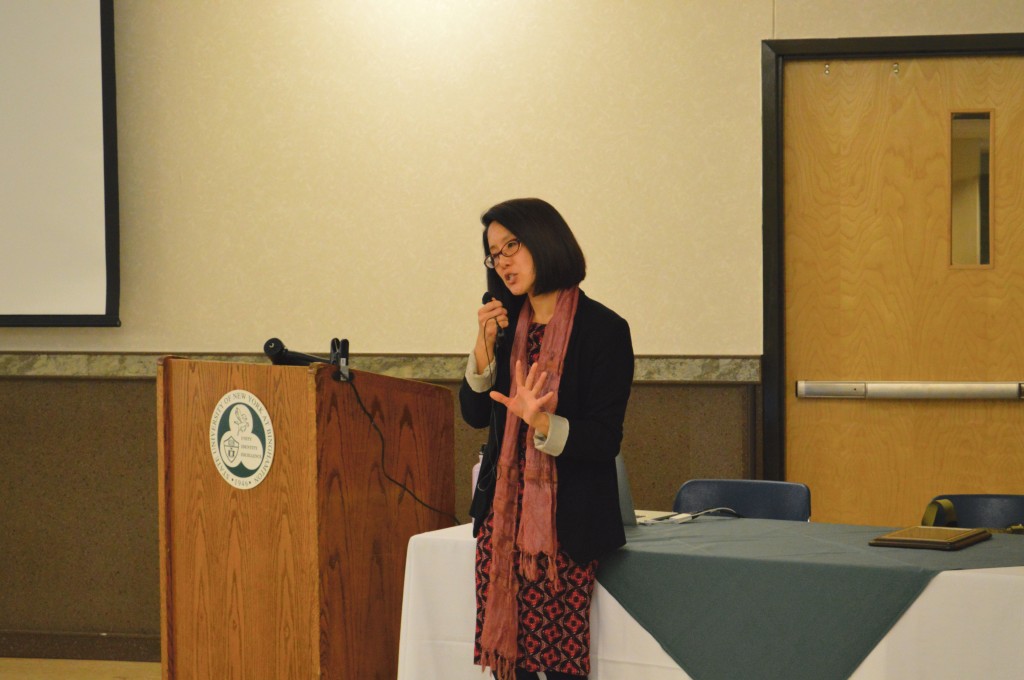
As crowds of students pack into Einstein Bros Bagels everyday to get their daily caffeine fix, they may not realize that they have a few things in common with a 15th-century Muslim mystic and Mocha, a crumbling city on the Red Sea in Yemen.
“When you order your mocha frappuccino or mocha latte, it is because of this particular moment … that the name became associated with coffee enduringly,” said Nancy Um, an associate professor of art history.
On Friday afternoon in Old Union Hall, Um gave a lecture titled “A Mosque, a Tomb and the Arabian Legacy of Coffee” as part of the Harpur College Dean’s Distinguished Lecture Series, an annual talk featuring one professor speaking about his or her research interests. Last year’s Distinguished Lecture was given by Benjamin Fordham, a professor of political science who spoke about the United States’ foreign policy and trade.
Um’s lecture focused on the influence of economic and political factors on the architecture of Mocha. She shared her research experience in Mocha, which was once a prosperous port city, to demonstrate how history can be used to understand architecture.
“Mocha, even in its dilapidated state, represented an opportunity,” Um said. “It inspired me to think about buildings in a new way.”
Um looked at two of the remaining buildings in the ruins of Mocha for her study: the Tomb and the Mosque of al-Shadhili, both of which commemorate the patron saint of the city. Al-Shadhili, who was a powerful member of a mystical sect of Islam called the Sufi, is often associated with the popularization of coffee drinking in the 15th century.
According to Um, Sufi Muslims would drink coffee in order to stay alert during rituals that often lasted through the night. Prior to that, coffee beans had been consumed as food in countries like Ethiopia.
For Alexandra Feim, a senior majoring in art history, Um’s account of the Arabian origins of coffee provided a new perspective on a history that has mostly been told from a European context.
“It makes you think about how there is such a long and complex history of beans growing in the Arabic regions and how that became the Starbucks coffee we get every day,” Feim said.
Um explained that Mocha became an epicenter in the trade of coffee beans to places as far as the American colonies. Although the beans were cultivated in the Yemeni mountains, she said, the English, Dutch and French all had factories within the city.
“Coffee has been the reason for the rise of a lot of important port cities,” Um said. “A lot of buildings have emerged to facilitate the coffee trade.”
The architecture of Mocha not only represents the influence of coffee, but also reveals a history of political maneuvering by the Ottoman Empire, which used Mocha as a naval base in the 16th century, she explained. Government officials from the Ottoman Empire refurbished the Tomb and built the Mosque not only to revere al-Shadhili, but also to placate different sects of Islam, namely the Sunni and the Zaidi, who lived in the area and had often clashed over religion and politics.
“These buildings shouldn’t just be seen as simple pious contributions,” Um said. “Buildings were responses in brick and stone to historically particular instigations in a dialogue that was extremely heated.”
Weaving coffee trade and Ottoman rule into the narrative of the Tomb and the Mosque provided a lens of study that is not common in art history, said Ricardo Laremont, a professor of political science and sociology.
“A lot of art historians don’t do that,” Laremont said. “They don’t make a connection between the art and economics and politics in society. That’s what makes her work so distinctive.”
Um concluded the lecture with the end of Mocha’s dominance of the coffee trade in the 18th century as coffee trade and production moved west. Although many of the buildings in Mocha have crumbled over time, the Tomb and the Mosque of al-Shadhili still stand as a reminder of the former prominence of Mocha.
“Today when you look at these structures, none of these historical layers are visible or accessible,” Um said. “They help us to understand the shifting but important place of the city between the various oceanic spheres and the commercial networks it was deeply embedded in.”


